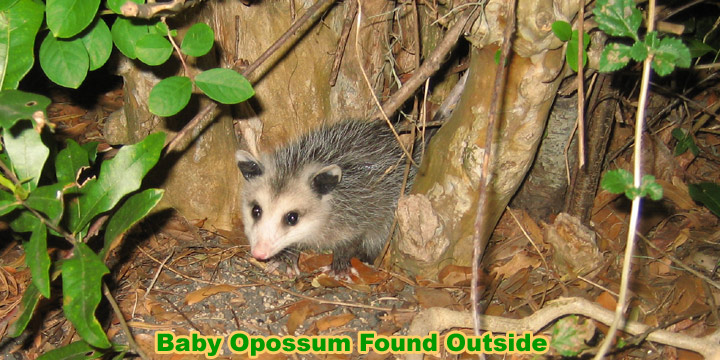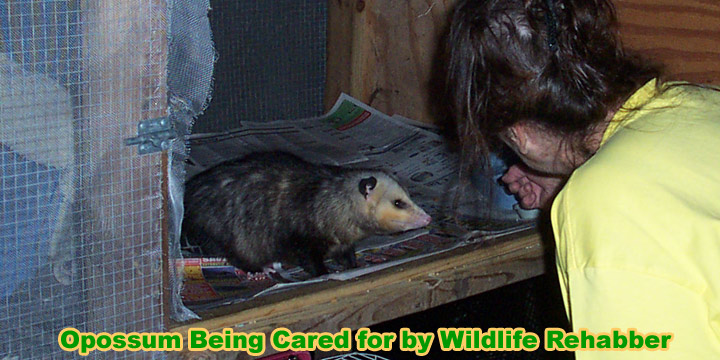|
|
What to do with a baby opossum I found?
I’ve found an injured Opossum. Now what? A good rule of thumb when dealing with an adult, wild animal is to never handle it unnecessarily. If the animal is seriously injured, and a wildlife rehabilitator can’t make it to you in time, consider the intervention of a veterinarian. Most companion animal hospitals will not see wildlife, and many are actually forbidden to by law. Some veterinarians, however, may have special licenses, especially if you’re lucky enough to contact the veterinarian for the local zoo. By gently and quietly assisting the injured animal into a container with air holes, take it to be accessed by the doctor. Because repeated therapy on a wild animal is both dangerous and difficult, a seriously injured adult will most likely be humanely euthanized. Adults with manageable injuries such as superficial lacerations or broken extremities will be released to a wildlife rehabilitator for the healing process.
DO NOT HANDLE THE ADULT WITHOUT HEAVY GLOVES. If avoidable, you should not handle the adult at all. A wild animal bite can pose a serious health threat and could even cause death through zoonotic disease.

To find a opossum rehabber in your area, click on my nationwide directory of wildlife rehabbers or do an online search for one in your area. In the meantime, you can still care for the opossum as advised below.
Instead of an adult, I’ve found babies! Now What? As a marsupial, opossums carry their infants around in a pouch. The most common reason babies are found is because a mother has been killed and the infants are discovered soon after. Baby opossums need to be kept warm, and this can be accomplished through the use of a warm water bottle, heating pad, or a bottle of warm rice. Take care to pad the bottle so that it does not roll onto any of the babies. Wearing gloves (always!), place the infants in the box with the heat source and with plenty of warm padding. Place the box in a dark, quiet area of the house.
Hydration is very important when it comes to baby animals. A dehydrated baby opossum will not be able to properly digest something as substantial as liquid formula. For this reason, you should try to administer an electrolyte supplement such as Pedialyte by mouth. Use a very fine eye dropper or a small feeding syringe, careful not to administer too much too quickly. Because of the close nose-to-mouth proximity, it’s very easy for infant animals to aspirate syringe-fed liquids into their lungs. Pneumonia is almost always fatal at this rehabilitation stage. Once you have the babies warm and hydrated, and time is more on your side, call the wildlife rehabilitator.
What is the rehabilitator going to do that I can’t? It’s not that you can’t physically take care of a baby opossum, it’s that in most states, the practice must be left to a wildlife professional. Even if you were willing, most people do not know the immense amount of time and energy that goes in to the care and rearing of a wild critter. Baby opossums will be fed by the wildlife professional at least every four hours in a twenty-four hour period. During this time, the babies will quickly learn to lap liquid with their tongues. Once this instinctual habit has begun, the formula and a separate bowl of water can be left for the young to lap at will. Puppy replacement formula is the most recommended formula for young opossums.

Infants will also need to be encouraged to eliminate after every meal. Warm, moist towels are usually used to wipe the belly and genital area of the opossum. This warm sensation will elicit an elimination of waste until the baby is able to recognize the stimulus on its own.
When the eyes begin to open, and the baby opossum is going to the bathroom on its own, the wildlife rehabilitator will begin to replace the liquid formula with a mixture of opossum diet foods. Dog kibble, because it is nutrient balance, is used as the foundation food for young opossums. By letting the kibbles soak in warm water and soften, they can then be mixed with small portions of any fruit or vegetable, as well as crickets and worms purchased at most pet stores. A calcium supplement is also provided to make sure bone growth is not negatively affected.
Many considerations occur when it is time for the wildlife rehabilitator to release opossums back into the wild. It is appropriate that opossums are leery of humans, even their current handlers. By keeping the animals, which are now around twenty weeks of age, in a large, outdoor enclosure, the expert is ensuring that the young adults can handle changes in temperature, light, sound, and can rely on their wild diet. Once released, it is common practice for a rehabilitator to leave the opossum’s nest box at the area of relocation. Food is provided for a few days after release.
If you have called a wildlife rehabilitator to take away baby opossums, consider offering a donation to their cause. Money, supplies, and volunteer help are all greatly appreciated by these kind-hearted caregivers.
Here are some other advice articles for wildlife rehabilitation:
What to do with a baby bat I found?
What to do with a baby deer I found?
What to do with a baby fox I found?
What to do with a baby opossum I found?
What to do with a baby raccoon I found?
What to do with a baby hawk or eagle I found?
What to do with a baby reptile I found?
What to do with a baby mouse or rat I found?
What to do with a baby songbird I found?
What to do with a baby squirrel I found?
|
|
 |
Please be kind to wildlife! Our wild animals are intelligent, and believe it or not, they definitely have emotions! |
 |
|
|
|